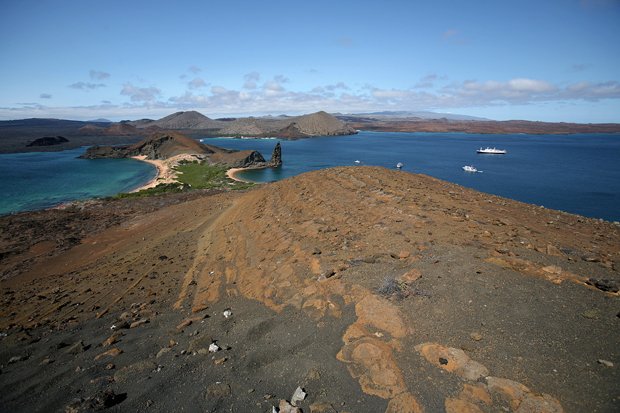Galapagos: ultimate nature adventure, day 3

Day 3. AG editor Ian Connellan Galápagos Islands, off the coast of South America.
THE MORNING VIEW OF Isla Bartolomé is of a land created and carved by volcanic forces so relatively recently that the very folds and splatters of lava are instantly recognisable. We know from Roberto’s briefing the night before that later in the day we’ll have a chance to get ashore and walk on lava flows only a century old.
In the morning we talk a short panga (small, hard-bottomed boatt) tour past aptly named Pinnacle Rock and see our first Galápagos penguin before heading ashore to walk up the 300+ steps to the lookout on Bartolomé.
There’s life down near the waterline – the usual marine iguanas and sea lions – but very little beyond, save the hardy and ever-present lava lizards and pioneer plant species such as lava cactus. We ascend past evidence of the Galápagos’s titanic origins, such as metres-deep volcanic ash beds, lava rocks expelled by explosion and various types of gas vents with their weirdly sculpted lava cones.
From the lookout there are fine views of eastern Santiago and the narrow channel between it and Bartolomé; in the distance, the Daphnes Major and Minor and Santa Cruz are prominent. After the walk we snorkel along the shoreline near Pinnacle Rock, and snorkel again straight after lunch along the front of the lava flow.
LAUNCH THE GALLERY
The second swim is the best – a playful young sea lion accompanies us for a good part of the way and we also see green turtles. Daniel nails some great underwater shots of a feeding Galápagos penguin.
The last activity for the day is a walk on the 105-year-old lava flows at the eastern end of Santiago that came close to reaching Bartolomé. The lava looks like some sort of fast-setting black cake mix, the patterns frozen in it are so vivid you can almost imagine it molten. It’s mostly a kind of shiny black, broken by flashes of colour – green, white, orange – caused by concentrations of minerals. It’s uneven, buckled and desolate; dislodged or wobbly slabs make a ceramic sound. Only lava lizards, spiders, insects and very rare plant life break its barren appearance.

Lava patterns
Read more blogs in the Galápagos series
Find out more about the next Peregrine/AG trip with Ian Connellan to see Borneo’s orangutans.

